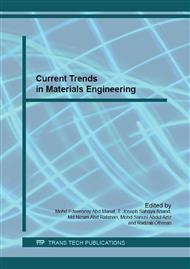p.133
p.138
p.143
p.151
p.155
p.160
p.167
p.172
p.179
The Effect of Argon Controlled Pre-Oxidation on TGO Formation of NiCoCrAlYTa/YSZ
Abstract:
Thermally grown oxide (TGO) plays important roles in thermal barrier coating system (TBC) for high temperature application such as in aircraft gas turbine engine blades (GTE). The TGO formed between the bond coat and topcoat interface can increase oxidation resistance to creep of GTE blades by minimizing oxygen diffusion into the metal substrate. In this research a NiCoCrAlYTa metallic bond coat was deposited on Inconel 625 substrate using two methods of deposition namely; high velocity oxy-fuel (HVOF) and atmospheric plasma spray (APS). After coating process, both types of samples underwent pre-oxidation in argon furnace for 12-24 hours at 1000 °C. Results showed that the TGO formation for samples in which the bond coat deposited via HVOF method produced much thinner and continuous TGO formation compared to APS deposition. This TGO characteristic is very useful to lengthen the lifetime of the metals substrate.
Info:
Periodical:
Pages:
155-159
Citation:
Online since:
May 2016
Price:
Сopyright:
© 2016 Trans Tech Publications Ltd. All Rights Reserved
Share:
Citation:


